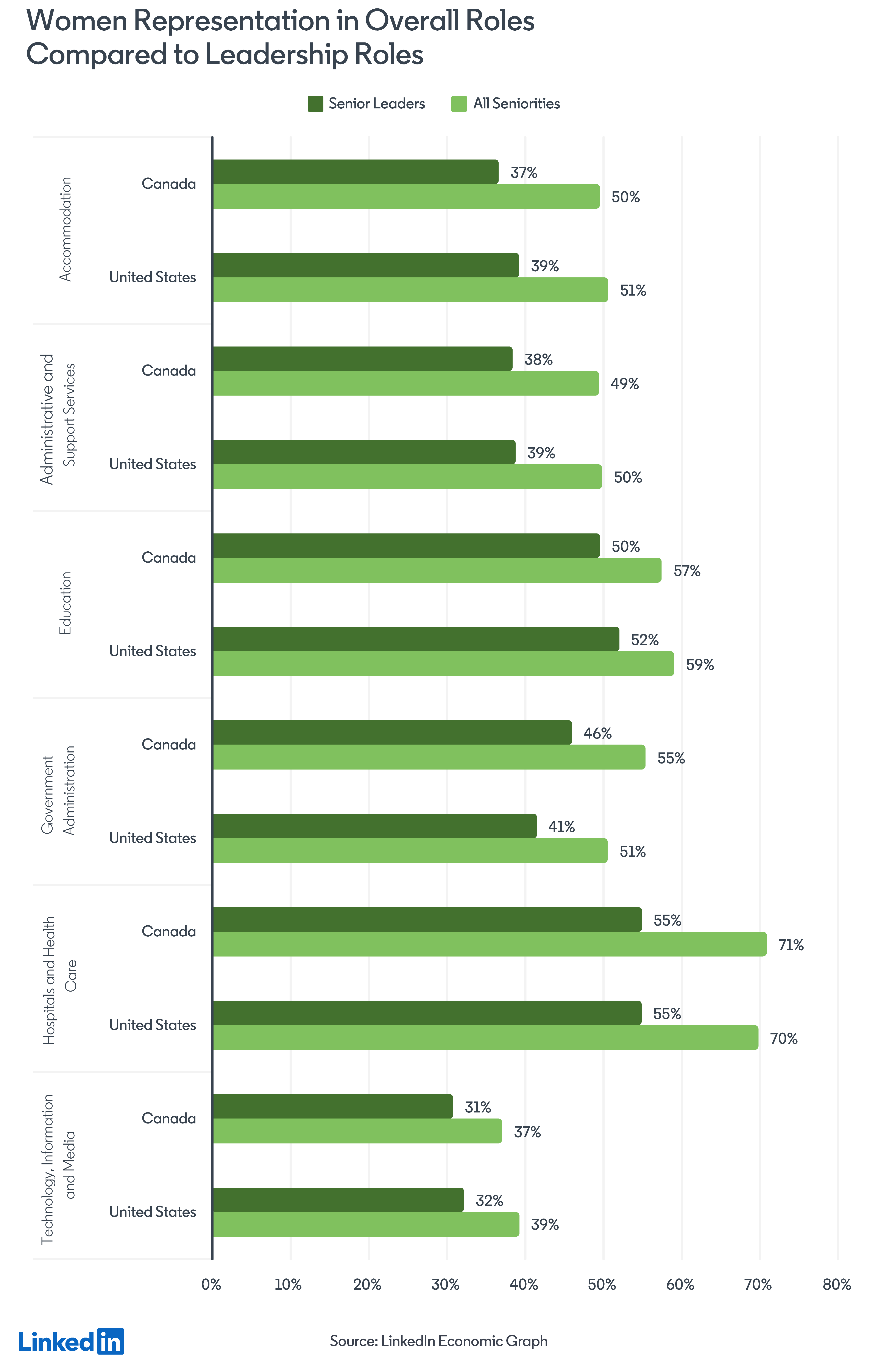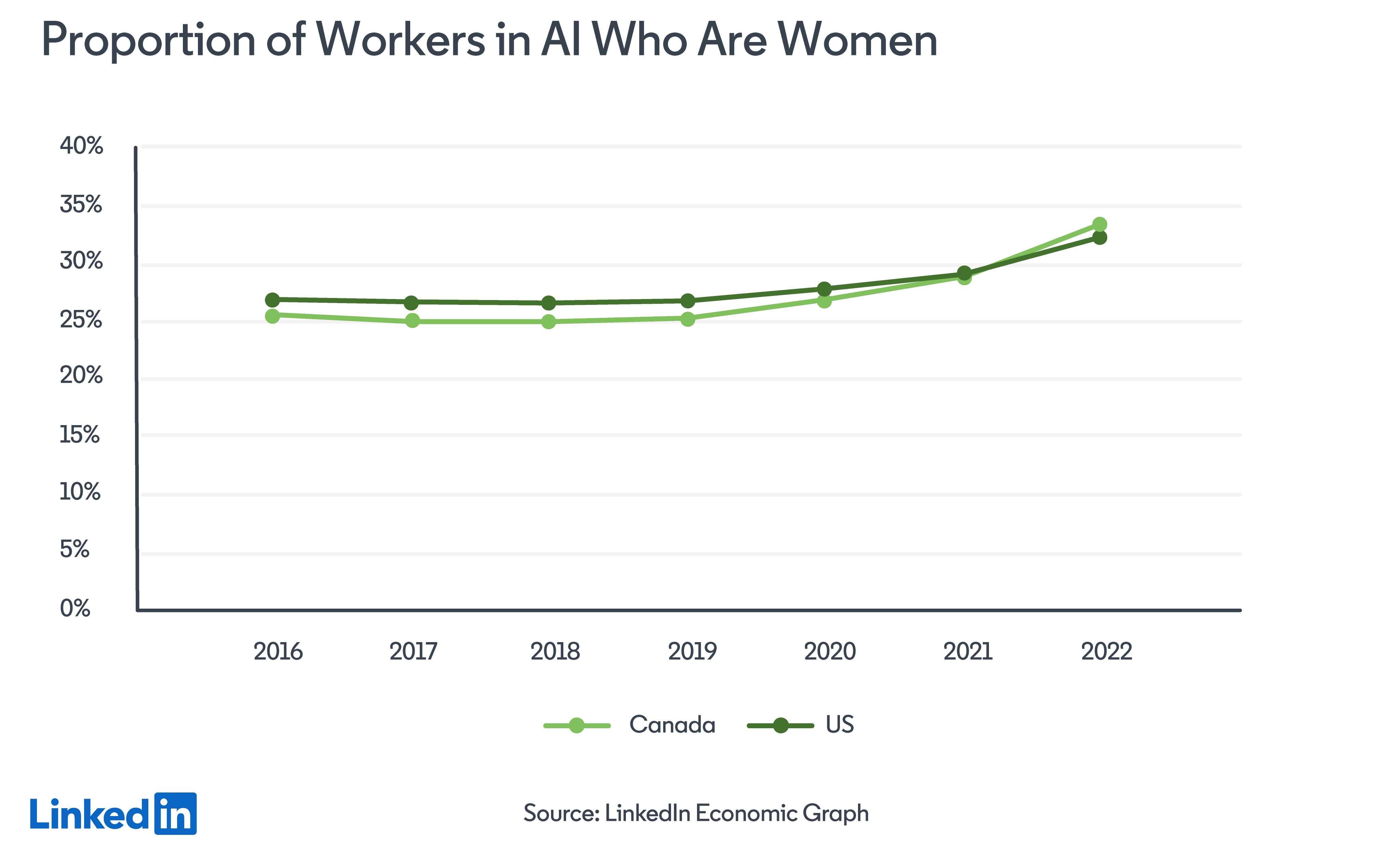
Women Are Still Underrepresented in Leadership and the Technology, Information and Media industry
Despite years of continual efforts to promote gender equality in the workplace, women remain underrepresented in leadership positions. This lack of diversity not only limits organizations' potential to thrive but also reinforces gender biases. We did a deep dive on leadership gender representation in the United States and Canada using LinkedIn data, with a deeper dive into the Technology, Information and Media industry. The analysis highlights the need to continue to implement policies that promote gender diversity. These include expanding the talent pool by hiring for skills (and not only employment history or degrees), promoting flexible work arrangements such as remote work to accommodate the needs of all workers, and continuing to remove barriers for women for being promoted into leadership positions.
In many industries, women face obstacles that hinder their career progression, resulting in a disproportionate number of men occupying top positions. Globally, we estimate that less than a third of leadership positions are held by women. In the United States and Canada, the situation is not much better, with only 37% and 35% of leadership positions being held by women, respectively, despite women comprising 47% and 46% of the workforce. We found this same gender gap - a smaller proportion of women in leadership positions than the overall proportion of women in the workforce - in each industry we examined in the United States and Canada.
Despite the fact that in entry-level roles, women are achieving parity with men or even holding the majority in certain sectors, their representation in leadership positions remains significantly lower due to various biases that obstruct their career progression. For example, in the United States and Canada, women comprise approximately half of all workers in the Accommodation industry and in Administrative and Support Services, yet hold around 40% of senior positions in each of these industries. The same is true for Government Administration in the U.S., although Canada has slightly higher numbers, with 55% female workers and 46% of leadership positions held by women. Even in industries where women hold a clear majority of all positions, such as Hospitals and Health Care (approximately 70% of workers) and Education (approximately 60% of workers), they still struggle to secure half of senior positions.

The technology, information and media industry presents another clear example of gender gaps. In the United States, women make up approximately 39% of the workforce in this industry, but only 32% of leadership positions - and these numbers have largely held true since 2018. The situation is similar in Canada, where 37% of technology workers are women, but only 31% hold leadership positions. It is helpful to take a closer look at this sector in particular, as it represents an area where too few women are entering employment and too few are being promoted to senior positions among those who do.
This can be observed by examining gender representation across each progressive point of the seniority ladder, revealing a decrease in female representation as positions become more senior. This trend holds true both overall in the US and Canada and in the technology, info and media industry, as an example. The largest drop-off in female representation occurs at the most senior levels. This industry suffers from underrepresentation of women at every seniority level, with the gap only widening for more senior positions. These trends result in women holding only 30% of VP positions compared to 70% for men, and as low as 20% for CXO positions.

The tech, info and media sector not only displays pervasive underrepresentation of women in the US and Canada, but it also provides important insights into the potential future evolution of gender gaps in employment. With many higher-paying job opportunities and increasing reliance on technology, the industry will only grow in importance over time. If existing gender gaps persist, they will only exacerbate the overall disparities in the economy between men and women. Focusing on a particularly promising area for growth, Artificial Intelligence (AI), women represented only 33% of AI workers in Canada in 2022 and 32% in the United States. This means that men are twice as likely as women to be in AI. While this represents strong progress over the last five years (up from around 26%), it is still well below parity with men and even below the proportion of total tech workers who are women (as reported above). In other words, women are not only underrepresented in tech, an industry expected to grow, but they are even more underrepresented in a rapidly growing area like AI and in leadership roles within the industry.

If we were to hire for relevant skills instead of looking for candidates who held the same job title in the past then representation would likely improve. As shown in work by our colleagues examining jobs where women are especially underrepresented, when hiring for skills, the global talent pool would expand by 24% more for women than for men. In the United States, there would be a 26% additional gain, and in Canada, 19%.
Although these findings highlight significant gender disparities in the labor market, there have been some positive developments in recent years. For example, the share of women in AI has increased over the last five years, suggesting that efforts to promote diversity and inclusion in this field are beginning to yield results. Additionally, the share of women hired into leadership positions has improved in Canada and the U.S., where the proportion of women hired into leadership positions has increased by around five and four percentage points, respectively, since 2016. This trend has outpaced the slower growth in the overall proportion of women in leadership positions over the same period. The tech industry has also shown signs of progress, with the proportion of women hired into leadership positions on the rise, albeit from lower levels. Nonetheless, much work remains to be done to close the gender gap in the labor market, particularly in fields where women remain significantly underrepresented.

Gender disparities in the labor market cannot be eliminated through a single policy or product. However, consistent attention to a wide range of strategies can help mitigate discrimination and reduce gaps. Our data offers insights into potential avenues for mitigation. For instance, our findings indicate that in January 2023, women in the US were 5 percent more likely than men to apply for remote jobs (55% versus 50%), and in Canada, the gap is 2 percentage points (33% versus 31%). For both, that gap in interest for remote job postings has persisted over time. This suggests that women may be more interested in flexible work arrangements, which can help make workplaces more equitable. However, it is crucial to ensure that flexibility is available to all employees to avoid exacerbating the burden of care that many women already face. Although remote job postings have decreased, application rates have remained high for both men and women, indicating that flexible arrangements continue to be important.
Our analysis highlights the persistence of gender disparities in the labor market in the United States and in Canada, including in promotion to leadership and in the technology industry and its subsets such as AI. These gaps have far-reaching implications not only for individual women but also for society as a whole. While some progress has been made in recent years, there is still a long way to go in achieving gender equality in the workforce. Our findings underscore the importance of policies and practices that address discrimination and promote diversity, including expanding the talent pool by hiring for skills rather than job titles, providing flexible arrangements to accommodate the needs of all workers, and creating opportunities for women to advance into leadership positions. By continuing to monitor and address gender disparities in the labor market, we can build a more equitable and prosperous future for everyone.
++++++++++++++++++++++++++++++++++++++++++++++++++++++++++++++++++++++++++++
Read more about women in the workplace in EMEA and LATAM and the Asia Pacific region.
This analysis includes commentary on the trends we see within LinkedIn’s data. Gender identity isn’t binary and we recognise that some LinkedIn members identify beyond the traditional gender constructs of “man” and “woman.” If not explicitly self-identified, we have inferred the gender of members included in this analysis either by the pronouns used on their LinkedIn profiles, or inferred on the basis of first name. Members whose gender could not be inferred as either man or woman were excluded from this analysis.
The share of women in senior leadership represents the total number of women holding Director, VP, C-suite or Partner positions divided by the total number of men and women holding these positions. An ‘AI’ job is an occupation that requires AI skills to perform the job. Skills penetration is used as a signal for whether AI skills are prevalent in an occupation representative, in any sector where the occupation representative may exist. A LinkedIn member is considered AI talent if they have explicitly added AI skills to their profile and/or they are occupied in an AI job.
Insights presented in this article were made possible through the research conducted by Silvia Lara, Rosie Hood and Matthew Baird on gender inequity, Murat Erer and Akash Kaura on AI, along with Caroline Liongosari and her work on remote applications by gender.
